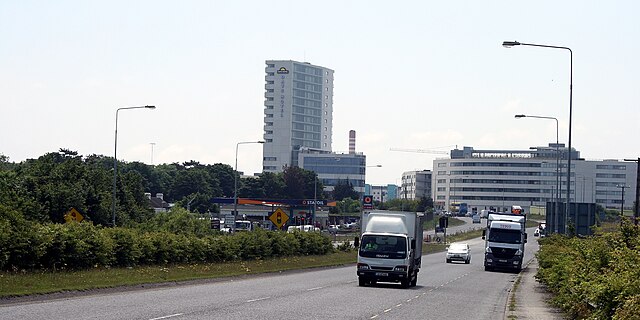The Ballymun Flats referred to a number of flats—including the seven Ballymun tower blocks—in Ballymun, Dublin, Ireland. Built rapidly in the 1960s, there were 36 blocks in total, consisting of 7 fifteen-storey, 19 eight-storey, and 10 four-storey blocks. The complex was built in a Corbusian style known as towers in the park, which was popular in European and American cities in the mid-20th century.
Joseph Plunkett tower with the Sillogue Road flats in the background.
A Ballymun street scene with some of the tower blocks visible in the distance, circa late-1990s.
The eight-storey flats contained two different designs, one where the lift was located opposite the stairwell (pictured right) and an alternative design where the lift was located on the same side as the stairwell, as seen here on Sillogue Road, the four-storey Sillogue Avenue can be seen in the middle.
Connolly tower.
Ballymun is an outer suburb of Dublin, Ireland, at the northern edge of the Northside, the green-field development of which began in the 1960s to accommodate a housing crisis in inner city areas of Dublin. While the newly built housing was state-of-the-art at the time, comprising high-rise tower blocks and flat complexes, residents were moved in years before shops, schools and other infrastructure were fully ready, and the area became well known for both a strong community spirit and considerable social challenges. Ballymun has several sub-districts such as Sillogue, Coultry, Shangan and Poppintree, and is close to both the Republic of Ireland's only IKEA store and to Dublin Airport. The area is the source of one Dublin river, and parts lie in the floodplain of another, and there are a number of parks.
A view of the regenerated Ballymun town centre as of 2007
Welcome to Ballymun bilingual sign
A former Ballymun Tower
New Ballymun under construction







